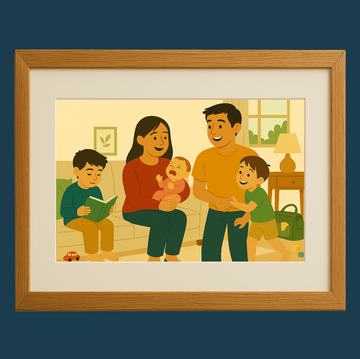My son can’t walk or talk and uses an intricate wheelchair with a harness and head prompts to remind him to sit upright. Kids watch his movements and try to understand him. Sometimes they point and ask their parents questions like “Why is he like that?” and “What’s wrong with him?” Being on the receiving end of constant staring is hard and uncomfortable.
As a mom of three whose children also have questions about the different people they encounter, I know it can be difficult to respond appropriately. Your instinct may be to say, “That’s not polite!” I get it — we’re all going about our days just trying to get from one place to another. So, what is the right reaction in those moments? How can a parent talk to their child about people who look different so their child learns and the person with the disability feels seen but not uncomfortable? Is it the parent’s job to educate their child, or is it the job of the person with the disability (or their caregiver) to educate the world? After speaking with experts, I’ve found these are the best strategies to use when you find yourself in this sort of situation.
Don't Pull Away
“Curiosity is a gift,” says Dr. Yvette Pegues, , Ed.D., an inclusive-education specialist and a board member of The Arc of the United States who uses a wheelchair full-time. “It’s developmentally appropriate for children to want to understand difference.” She explains that children need to be allowed to be children and that apologizing or scolding them for their curiosity can potentially shut them down.
Sarah Kovac, Editor of Accessibility at Reviewed who has a disability herself, says, “The most unfortunate thing that can happen when a child notices me is to have an adult whisk the little one away or scold them for staring. The child is not learning politeness in that moment. They're learning to be afraid of disabled people.”
A better response is to teach children how to engage, Kovac says. “A parent with a child who notices a disability can do a great service to all involved by engaging with me or allowing the child to. I am not in the least offended by their questions. I’ve heard it all and I have age-appropriate replies at the ready. If the kid is too nervous to approach a stranger, as I would have been, show them how to be brave and ask questions on their behalf. When they see me smile and talk and interact with another adult, they get the opportunity to see me as a human, just like them.”
Be a Role Model
“Just as with any behavior we want our children to learn, one of the most effective ways to teach is to model that behavior ourselves so the child gets a visual of what to do,” says Trish Allison, author of DEI Parent Guildebooks, How to Respond to Disability Curiosity from Kids. “The best things for parents to do in this situation is to take their child aside and explain, quietly, that the person has a body part — brain, leg, eyes, etc. — that works differently than ours. Other than that, they're just like you and me. Parents can tell their child it's okay to notice. They can smile, say hi, or wave, but try not to stare.”
Dr. Emily W. King, a child psychologist, says it can be hard even for adults, but the effort is worth it. “Pushing through your own discomfort and coaching your child on understanding differences is a form of breaking cycles of discrimination and exclusion,” she says. It’s easy to get caught off guard, but stumbling and then finding words to bridge a gap in misunderstanding can go a long way in creating connection.
We all want to be seen, valued and heard. Rather than shying away from questions you don’t have answers to, admit that you don’t know, and be willing to learn more about someone different. “There is nothing innately inferior about a difference in functioning,” says Laura Phillips, Psy.D., A.P.Bd.N., senior director of the Learning & Development Center at the Child Mind Institute. “We don’t want to perpetuate an ableist society.”
Find Commonality
“As a parent, you may feel embarrassed that your child is staring. But don’t let that stop you from showing up in this crucial moment to teach kids about neurodiversity and inclusion,” Dr. King says. “Connect the moment to something familiar for your child. A parent can say ‘I see you’re noticing that little girl in a wheelchair. Some kids move around by walking and some use wheelchairs.’”
Aside from explaining why someone is different, parents can find a commonality so the child can relate to the person with disabilities. “Open the door for a respectful conversation,” says Melissa Hart, author of the book Daisy Woodworm Changes the World which has a main character based on her brother who has Down Syndrome. For example, if your child and a child with differences are in a social situation, you can try to bring up topics they might have in common to try to break the ice. “His favorite color is blue,” you can say of your child. “What’s yours?” Or “We just watched the latest Marvel movie. Have you seen it?” These are easy ways to open up a conversation and find similarities rather than differences.
Read the Room
Once, when a child was staring at my son, the parent said to me, “You should use this as a teachable moment.” Back then, my kids were all under 6 years old, and we were in a slippery locker room getting ready for swim lessons. I didn’t have the bandwidth to teach someone else’s child about disability in that moment.
But sometimes, I take it upon myself to give other children an opportunity to meet my son. For example, at a child’s birthday party, I modified the craft activity so my son could participate. I explained to the other kids that he loves to draw and to be included in the fun, but he needs help.
If your child is staring at someone with a disability, and you’d like to find out more, Dr. Pegues suggests first asking, “I see that my child is staring. I think they're curious about you. Do you mind if we ask you a few questions?” Most people with disabilities are used to copious attention and will indicate whether they can or want to share details about it. “If you get a ‘no’ from the individual, then have a personal conversation with that child in the privacy of your car or home,” says Dr. Pegues.
Start at Home
“I recommend exposing your children to disability and educating them about it as early as possible so that when they encounter people like myself, they’ll have basic knowledge and be able to ask questions with some understanding,” says Christopher Groux, senior editor of accessibility at Reviewed, who has cerebral palsy. “I suggest reading books about people with disabilities, such as What Happened to You? as well as other books by disabled authors specifically designed to teach younger audiences how to react to those with disabilities. It helps people like me feel comfortable in our own skin.” Many toy companies now make inclusive dolls and toys that can open up conversations at home, too.
But nothing beats real experience. In an ideal world, kids would have experience meeting different types of people, either through families, friends, schools or through volunteering. This would give them much more of an opportunity to find those commonalities.
“Modeling proper behavior, combined with giving the right guidance at home, will help children understand what to do the next time they see a disabled person,” says Allison. “Their child will know instinctively on their own to wave, smile, or say hi.”
Personally, I love when strangers say hello or acknowledge my son in a friendly way. It’s not easy to find ways to include him, and it makes our whole family feel more welcome. “The big-picture message parents need to convey,” Allison adds, “is that disabled people are human beings who deserve kindness and respect just like everyone else.”
Take me back to the issue!
Check out all the stories from our first-ever Accessibility Issue, including expert-approved ways to future-proof your home, an interview with Broadway star Ali Stroker and more!

Jaclyn Greenberg has written for The New York Times, Huffpost, CNN, Wired, Parents and other publications. She's working on a memoir about sticking together as a family of five. You can connect with her on Twitter at jl_greenberg or Instagram at JaclynlGreenberg.



















